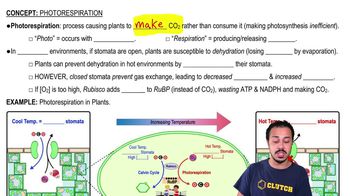Table of contents
- 1. Introduction to Biology2h 42m
- 2. Chemistry3h 40m
- 3. Water1h 26m
- 4. Biomolecules2h 23m
- 5. Cell Components2h 26m
- 6. The Membrane2h 31m
- 7. Energy and Metabolism2h 0m
- 8. Respiration2h 40m
- 9. Photosynthesis2h 49m
- 10. Cell Signaling59m
- 11. Cell Division2h 47m
- 12. Meiosis2h 0m
- 13. Mendelian Genetics4h 44m
- Introduction to Mendel's Experiments7m
- Genotype vs. Phenotype17m
- Punnett Squares13m
- Mendel's Experiments26m
- Mendel's Laws18m
- Monohybrid Crosses19m
- Test Crosses14m
- Dihybrid Crosses20m
- Punnett Square Probability26m
- Incomplete Dominance vs. Codominance20m
- Epistasis7m
- Non-Mendelian Genetics12m
- Pedigrees6m
- Autosomal Inheritance21m
- Sex-Linked Inheritance43m
- X-Inactivation9m
- 14. DNA Synthesis2h 27m
- 15. Gene Expression3h 20m
- 16. Regulation of Expression3h 31m
- Introduction to Regulation of Gene Expression13m
- Prokaryotic Gene Regulation via Operons27m
- The Lac Operon21m
- Glucose's Impact on Lac Operon25m
- The Trp Operon20m
- Review of the Lac Operon & Trp Operon11m
- Introduction to Eukaryotic Gene Regulation9m
- Eukaryotic Chromatin Modifications16m
- Eukaryotic Transcriptional Control22m
- Eukaryotic Post-Transcriptional Regulation28m
- Eukaryotic Post-Translational Regulation13m
- 17. Viruses37m
- 18. Biotechnology2h 58m
- 19. Genomics17m
- 20. Development1h 5m
- 21. Evolution3h 1m
- 22. Evolution of Populations3h 52m
- 23. Speciation1h 37m
- 24. History of Life on Earth2h 6m
- 25. Phylogeny2h 31m
- 26. Prokaryotes4h 59m
- 27. Protists1h 12m
- 28. Plants1h 22m
- 29. Fungi36m
- 30. Overview of Animals34m
- 31. Invertebrates1h 2m
- 32. Vertebrates50m
- 33. Plant Anatomy1h 3m
- 34. Vascular Plant Transport1h 2m
- 35. Soil37m
- 36. Plant Reproduction47m
- 37. Plant Sensation and Response1h 9m
- 38. Animal Form and Function1h 19m
- 39. Digestive System1h 10m
- 40. Circulatory System1h 57m
- 41. Immune System1h 12m
- 42. Osmoregulation and Excretion50m
- 43. Endocrine System1h 4m
- 44. Animal Reproduction1h 2m
- 45. Nervous System1h 55m
- 46. Sensory Systems46m
- 47. Muscle Systems23m
- 48. Ecology3h 11m
- Introduction to Ecology20m
- Biogeography14m
- Earth's Climate Patterns50m
- Introduction to Terrestrial Biomes10m
- Terrestrial Biomes: Near Equator13m
- Terrestrial Biomes: Temperate Regions10m
- Terrestrial Biomes: Northern Regions15m
- Introduction to Aquatic Biomes27m
- Freshwater Aquatic Biomes14m
- Marine Aquatic Biomes13m
- 49. Animal Behavior28m
- 50. Population Ecology3h 41m
- Introduction to Population Ecology28m
- Population Sampling Methods23m
- Life History12m
- Population Demography17m
- Factors Limiting Population Growth14m
- Introduction to Population Growth Models22m
- Linear Population Growth6m
- Exponential Population Growth29m
- Logistic Population Growth32m
- r/K Selection10m
- The Human Population22m
- 51. Community Ecology2h 46m
- Introduction to Community Ecology2m
- Introduction to Community Interactions9m
- Community Interactions: Competition (-/-)38m
- Community Interactions: Exploitation (+/-)23m
- Community Interactions: Mutualism (+/+) & Commensalism (+/0)9m
- Community Structure35m
- Community Dynamics26m
- Geographic Impact on Communities21m
- 52. Ecosystems2h 36m
- 53. Conservation Biology24m
28. Plants
Land Plants
Problem 2`
Textbook Question
The appearance of cuticle and stomata correlated with what event in the evolution of green plants?
a. The first upright growth forms
b. The first woody tissues
c. Growth on land
d. The evolution of the first water-conducting tissues
 Verified step by step guidance
Verified step by step guidance1
Understand the role of the cuticle and stomata in plants: The cuticle is a waxy layer that covers the surfaces of leaves and stems, helping to prevent water loss. Stomata are small openings on the surface of leaves that allow for gas exchange, crucial for photosynthesis.
Consider the environmental challenges plants faced when moving from aquatic to terrestrial environments: On land, plants needed to prevent desiccation (drying out) and manage gas exchange efficiently.
Recognize that the cuticle and stomata are adaptations to terrestrial life: These structures help plants conserve water while still allowing for the necessary exchange of gases (carbon dioxide and oxygen) for photosynthesis.
Identify the evolutionary event associated with these adaptations: The development of the cuticle and stomata is closely linked to the colonization of land by plants, as these adaptations were essential for survival outside of an aquatic environment.
Conclude that the appearance of cuticle and stomata is correlated with the growth on land, as these features were critical for plants to thrive in terrestrial habitats.
 Verified video answer for a similar problem:
Verified video answer for a similar problem:This video solution was recommended by our tutors as helpful for the problem above
Video duration:
1mPlay a video:
Was this helpful?
Key Concepts
Here are the essential concepts you must grasp in order to answer the question correctly.
Cuticle
The cuticle is a waxy, protective layer covering the epidermis of plants, primarily found in terrestrial plants. It serves to minimize water loss by evaporation and provides a barrier against pathogens. The development of the cuticle was crucial for plants to adapt to terrestrial environments, where water conservation is vital.
Recommended video:
Guided course

Pathogen Defenses
Stomata
Stomata are small openings on the surfaces of leaves and stems that facilitate gas exchange. They allow plants to take in carbon dioxide for photosynthesis and release oxygen, while also regulating water vapor loss. The evolution of stomata was essential for plants to thrive on land, balancing the need for gas exchange with water conservation.
Recommended video:
Guided course

Photorespiration
Growth on Land
The transition of plants from aquatic to terrestrial environments marked a significant evolutionary event. This shift required adaptations like the cuticle and stomata to manage water retention and gas exchange. Growth on land allowed plants to exploit new ecological niches, leading to increased biodiversity and complexity in plant forms.
Recommended video:
Guided course

Land Plants
Related Videos
Related Practice









